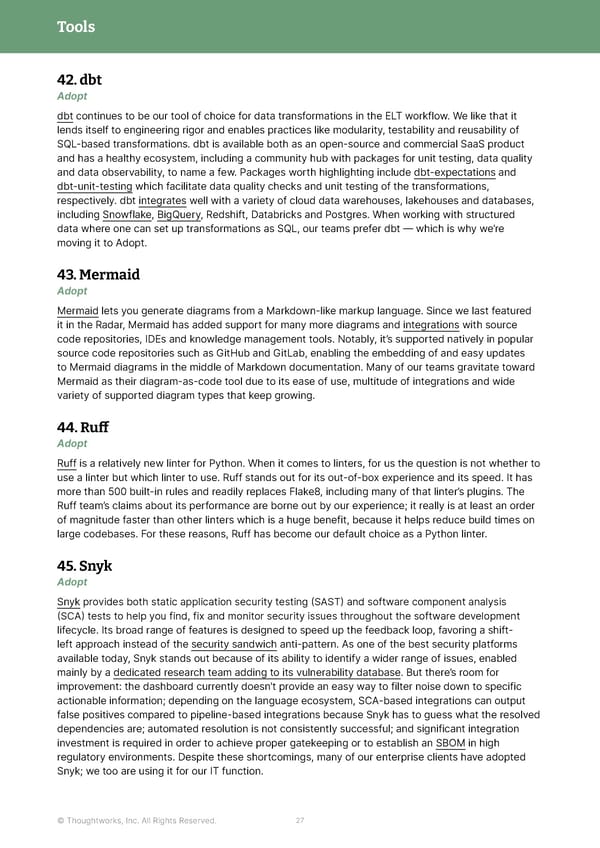Tools 42. dbt Adopt dbt continues to be our tool of choice for data transformations in the ELT workflow. We like that it lends itself to engineering rigor and enables practices like modularity, testability and reusability of SQL-based transformations. dbt is available both as an open-source and commercial SaaS product and has a healthy ecosystem, including a community hub with packages for unit testing, data quality and data observability, to name a few. Packages worth highlighting include dbt-expectations and dbt-unit-testing which facilitate data quality checks and unit testing of the transformations, respectively. dbt integrates well with a variety of cloud data warehouses, lakehouses and databases, including Snowflake, BigQuery, Redshift, Databricks and Postgres. When working with structured data where one can set up transformations as SQL, our teams prefer dbt — which is why we’re moving it to Adopt. 43. Mermaid Adopt Mermaid lets you generate diagrams from a Markdown-like markup language. Since we last featured it in the Radar, Mermaid has added support for many more diagrams and integrations with source code repositories, IDEs and knowledge management tools. Notably, it’s supported natively in popular source code repositories such as GitHub and GitLab, enabling the embedding of and easy updates to Mermaid diagrams in the middle of Markdown documentation. Many of our teams gravitate toward Mermaid as their diagram-as-code tool due to its ease of use, multitude of integrations and wide variety of supported diagram types that keep growing. 44. Ru昀昀 Adopt Ruff is a relatively new linter for Python. When it comes to linters, for us the question is not whether to use a linter but which linter to use. Ruff stands out for its out-of-box experience and its speed. It has more than 500 built-in rules and readily replaces Flake8, including many of that linter’s plugins. The Ruff team’s claims about its performance are borne out by our experience; it really is at least an order of magnitude faster than other linters which is a huge benefit, because it helps reduce build times on large codebases. For these reasons, Ruff has become our default choice as a Python linter. 45. Snyk Adopt Snyk provides both static application security testing (SAST) and software component analysis (SCA) tests to help you find, fix and monitor security issues throughout the software development lifecycle. Its broad range of features is designed to speed up the feedback loop, favoring a shift- left approach instead of the security sandwich anti-pattern. As one of the best security platforms available today, Snyk stands out because of its ability to identify a wider range of issues, enabled mainly by a dedicated research team adding to its vulnerability database. But there’s room for improvement: the dashboard currently doesn’t provide an easy way to filter noise down to specific actionable information; depending on the language ecosystem, SCA-based integrations can output false positives compared to pipeline-based integrations because Snyk has to guess what the resolved dependencies are; automated resolution is not consistently successful; and significant integration investment is required in order to achieve proper gatekeeping or to establish an SBOM in high regulatory environments. Despite these shortcomings, many of our enterprise clients have adopted Snyk; we too are using it for our IT function. © Thoughtworks, Inc. All Rights Reserved. 27
 Thoughtworks Technology Radar Page 26 Page 28
Thoughtworks Technology Radar Page 26 Page 28